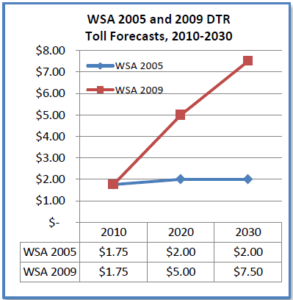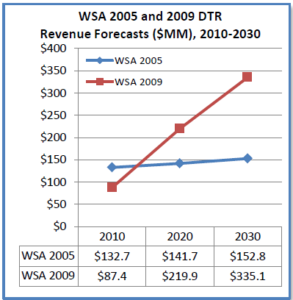by James A. Bacon
Wilbur Smith Associates (WSA), a transportation consulting firm, is scheduled to soon complete its third traffic and revenue forecast for the Dulles Toll Road for use in a final go/no go decision on Phase 2 of the Rail-to-Dulles project. Don’t trust the results, says a study released Friday by the Reston Citizens Association. WSA chronically over-estimates its traffic counts.
In “Wilbur Smith Associates’ Traffic and Revenue Forecasts: Plenty of Room for Error,” the authors provide an extensive review of the literature on the hazards of traffic forecasting. “Optimism bias,” the overestimating of road traffic and revenue in forecasts, is endemic in the industry, with a mean forecast error of 25% to 30% over actual traffic.
 The report is must reading for anyone concerned about the financing of Rail-to-Dulles Phase 2, which will come mostly from tolls paid by users of the Dulles Toll Road, as well as for citizens analyzing the economic viability of a slew of mega-bridge and highway projects being unleashed by the McDonnell administration. Over-optimistic traffic forecasts can induce public officials to proceed with projects that fail to live up to expectations, with potentially calamitous financial results. In the case of Rail-to-Dulles, if toll revenues fail to materialize as expected, the Washington Metropolitan Airports Authority (MWAA) could be faced with a decision to jack up rates more aggressively and incur the risk of driving away more commuters and falling short on revenue anyway.
The report is must reading for anyone concerned about the financing of Rail-to-Dulles Phase 2, which will come mostly from tolls paid by users of the Dulles Toll Road, as well as for citizens analyzing the economic viability of a slew of mega-bridge and highway projects being unleashed by the McDonnell administration. Over-optimistic traffic forecasts can induce public officials to proceed with projects that fail to live up to expectations, with potentially calamitous financial results. In the case of Rail-to-Dulles, if toll revenues fail to materialize as expected, the Washington Metropolitan Airports Authority (MWAA) could be faced with a decision to jack up rates more aggressively and incur the risk of driving away more commuters and falling short on revenue anyway.
According to the Reston Citizens’ report, a national study of 26 U.S. toll roads found that the average overestimate of revenues for each year of the first five years was 109% — more than double actual revenues. WSA accounted for half the identifiable forecasts and its results differed little from the others.
Absent significant changes in WSA’s methodology, the Reston Citizens report warns that WSA’s upcoming study is likely to over-estimate revenues again. In two earlier forecasts, WSA had used the highest available estimates of population and employment data for Fairfax County. “Checked against the 2010 data, the forecasts for employment were overstated by 25% in the 2005 report and 52% in the 2009 report, contributing to near certain overestimates in the forecast.”
WSA’s Dulles Toll Road forecasts also showed huge, unexplained discrepancies in toll and revenue forecasts between its 2005 and 2009 reports. “WSA’s 2009 forecast for 2030 t0lls are nearly quadruple and revenues double those in the 2005 report.”
The Reston Citizens report identifies five risks from over-estimating Dulles Toll Road traffic and revenue:
- The risk that the financial community will not fund MWAA’s Dulles Toll Road debt or will require state or federal guarantees or funding for an investment grade rating.
- The risk that toll rates would need to double those forecast by WSA to meet debt servicing and other expenses.
- The risk that the higher toll rates on the Dulles Toll Road will limit the economic development potential of the Dulles Corridor as well as force traffic on to already congested nearby roads.
- The risk that MWAA would have to use airport revenues to pay Dulles Toll Road debt servicing obligations.
- The risk that MWAA may default or need to restructure its debt servicing agreements,resulting in more debt over a longer period and even higher tolls for toll road users.
The Reston Citizens reports urges Rail-to-Dulles stakeholders to defer making a decision to proceed with Phase 2 until an independent Traffic Revenue forecast can be completed.
Bacon’s bottom line: I am extremely skeptical of traffic forecasts of any kind — for rail, road, highway — based on an extrapolation of past trends. I believe we have reached a major inflection point in the economics of transportation and land use, and that the past is no predictor of the future. By way of evidence, consider these previous blog posts:
Is Virginia’s Population Growth Slowing?
Demographic Trends and Trends and Traffic Projections
Stacking the Deck for Heavy Rail
A New Metric for Gasoline Affordability
Virginians Driving Even Less in 2011
Perhaps the most critical inflection point for Northern Virginia is the impending stall in the key driver of Northern Virginia’s population and economic growth: federal spending. You don’t have to accept my Boomergeddon hypothesis that the federal government will default on its debt to believe that spending cannot continue on the same upward trajectory that it has for the past 50 years. Something has to give, and when it does, Northern Virginia will feel the fall-out.
I agree 100% with the Reston Citizens Association that the Rail-to-Dulles stakeholders should engage an independent Traffic & Revenue forecast. I would also insist upon a sensitivity analysis that shows what traffic and revenue looks like under different a variety of population and economic growth forecasts for the region. To fail to do so would be the height of fiscal irresponsibility.



